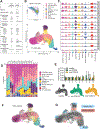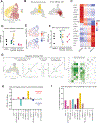Inhibition of CDK4/6 Promotes CD8 T-cell Memory Formation
- PMID: 33941591
- PMCID: PMC8487897
- DOI: 10.1158/2159-8290.CD-20-1540
Inhibition of CDK4/6 Promotes CD8 T-cell Memory Formation
Abstract
CDK4/6 inhibitors are approved to treat breast cancer and are in trials for other malignancies. We examined CDK4/6 inhibition in mouse and human CD8+ T cells during early stages of activation. Mice receiving tumor-specific CD8+ T cells treated with CDK4/6 inhibitors displayed increased T-cell persistence and immunologic memory. CDK4/6 inhibition upregulated MXD4, a negative regulator of MYC, in both mouse and human CD8+ T cells. Silencing of Mxd4 or Myc in mouse CD8+ T cells demonstrated the importance of this axis for memory formation. We used single-cell transcriptional profiling and T-cell receptor clonotype tracking to evaluate recently activated human CD8+ T cells in patients with breast cancer before and during treatment with either palbociclib or abemaciclib. CDK4/6 inhibitor therapy in humans increases the frequency of CD8+ memory precursors and downregulates their expression of MYC target genes, suggesting that CDK4/6 inhibitors in patients with cancer may augment long-term protective immunity. SIGNIFICANCE: CDK4/6 inhibition skews newly activated CD8+ T cells toward a memory phenotype in mice and humans with breast cancer. CDK4/6 inhibitors may have broad utility outside breast cancer, particularly in the neoadjuvant setting to augment CD8+ T-cell priming to tumor antigens prior to dosing with checkpoint blockade.This article is highlighted in the In This Issue feature, p. 2355.
©2021 American Association for Cancer Research.
Figures






References
Publication types
MeSH terms
Substances
Grants and funding
LinkOut - more resources
Full Text Sources
Other Literature Sources
Medical
Molecular Biology Databases
Research Materials

